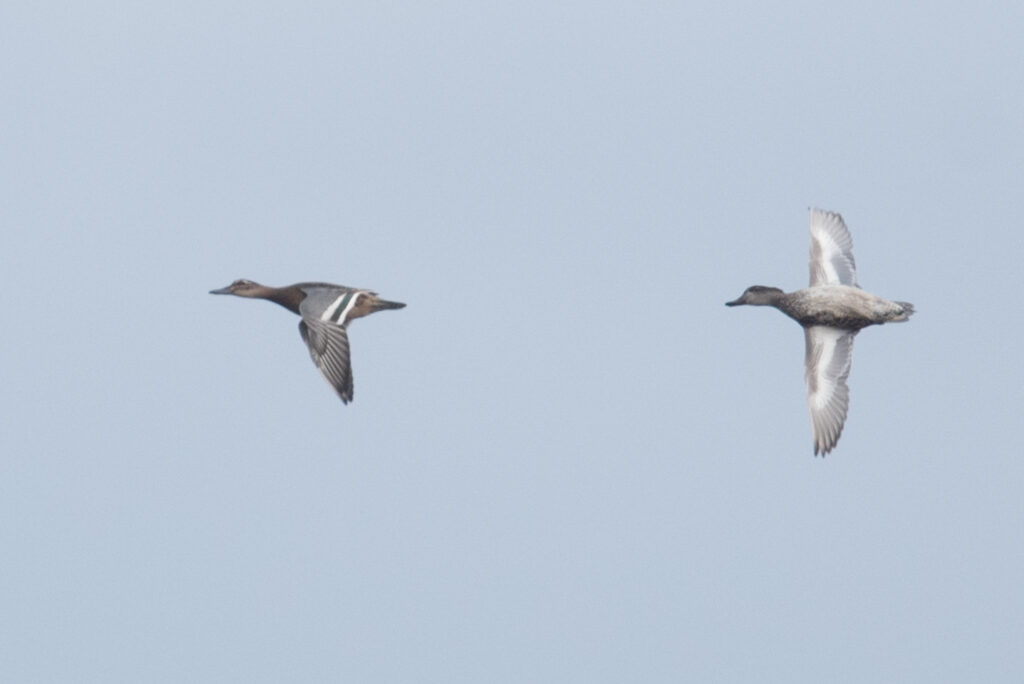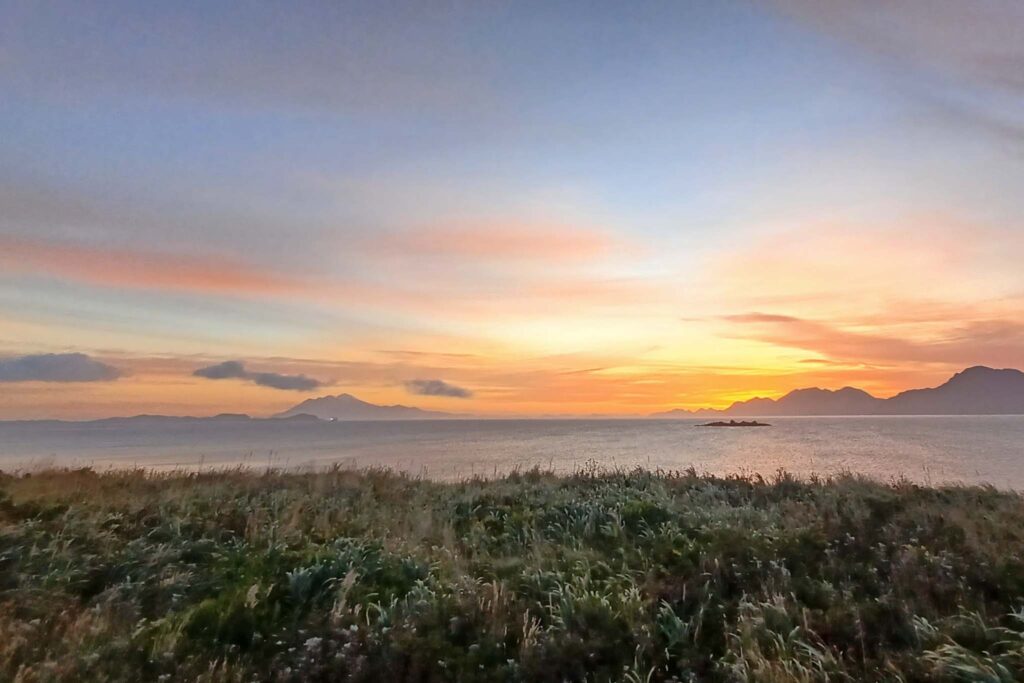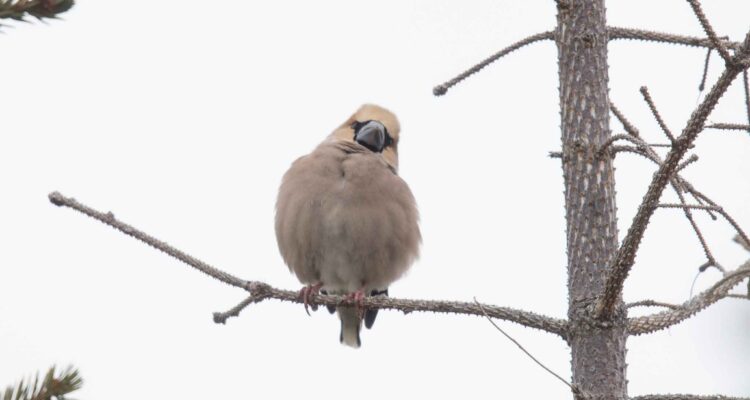Our 14th spring tour to Adak Island was perhaps our best yet, especially when measured by…

Adak Island Strikes Again!
Our third trip to Adak during fall migration is in the books! Each of our three visits has been successful, yet each has been very different from the previous. Our 2022 trip was highlighted by rare shorebirds, good shorebird diversity, and a thrillingly rare songbird. In 2023, much of the excitement came in the form of waterfowl. This year our birding highlights came at us from several directions—a very rare passerine, exciting waterfowl, and exceptionally good seawatching!
We arrived on the island in uncommonly pleasant conditions and hit the ground running. A PEREGRINE FALCON was flying around the plane as we walked to the terminal and on the short drive to the rental house we had great views of GYRFALCON flying right next to our trucks. Nice start! After settling at the house, we made our first of many trips to Clam Lagoon. In a flock of about 200 EURASIAN GREEN-WINGED TEAL, we had great looks and photo opportunities of three GARGANEY! These birds were found before we arrived on the island and had been playing hide-and-seek with birders. This evening, however, they seemed to enjoy the spotlight and were in the open more often than not.


All was well. We had arrived on the island, were already enjoying some great birding, and found a rarity on our first evening. Just before heading to bed, we got word that others on the island had seen a flighty thrush near the Lake Andrew Rec Center. They got a few flight shots of the bird which showed clearly that it was a SONG THRUSH—the first record for Adak and only the 4th record for Alaska! So we made plans to join them early the next morning to try to relocate it. I’m normally a pretty optimistic person, but from their description of the bird’s flighty behavior and the location I wasn’t too positive about our odds of finding it. This was one time when I was happy to be wrong! We lined up in the fashion that birders do on islands in the Bering Sea in the fall, and swept forward. And just according to plan, the Song Thrush flushed out of the same area as the night before and briefly perched in a spruce tree. We spent the morning working to get more looks of this furtive thrush, and with some effort all of us were eventually able to get views and some even got a few photos. Not even 24 hours into the trip and all of us, including both leaders, had a life bird!

Over the next couple of days, we diligently checked and rechecked stands of planted spruce, willow thickets, mudflats, and wetlands looking for the expected and the unexpected. In the expected category we found ROCK PTARMIGAN, TUFTED DUCK, LAYSAN ALBATROSS, SHORT-TAILED SHEARWATER, COMMON SNIPE, SHARP-TAILED SANDPIPER, CRESTED AUKLET, EMPEROR GOOSE, TUFTED PUFFIN, YELLOW-BILLED LOON, RED-FACED CORMORANT, GRAY-CROWNED ROSY-FINCH, and more. In the unexpected category, we had DOUBLE-CRESTED CORMORANT (perhaps only the third record for Adak Island), and BRANT. Not exactly what most folks were hoping to see on west winds, but rare birds nonetheless.

Storms are often the driver of birding excitement in western Alaska in the fall and this trip was no exception. On day six of our eight-day trip, a massive low-pressure system passed just north of Adak Island and brought with it sustained west winds of 40-50 miles per hour for the entire day. Gusts of around 65 miles per hour made it difficult to be outside. The only real way to bird was to find somewhere tucked out of the wind and train your binoculars and scopes on the sea. We always hope for rare seabirds to come inshore in such conditions and on this trip it finally happened! Early in the afternoon in the relatively protected Finger Cove, we watched at length a LEACH’S STORM-PETREL flutter not far offshore. Encouraged by this, we repositioned near the harbor, hid in the lee of the vehicles, and set up our scopes to see if any other seabirds were taking shelter inshore. We noticed a fairly close band of SHORT-TAILED SHEARWATERS flying just outside of the islands near the harbor entrance and trained our scopes on the band. Short-tailed Shearwaters are an expected species at Adak in the fall. After just a few minutes of seawatch, we picked up our first MOTTLED PETREL which flew inside of the islands, closer than all of the shearwaters! Several other Mottled Petrels joined in and before long we had all achieved great scope views of this seldom-scene tubenose! It looked like the viewing might be even better further along Bayshore Drive, near Water Tower Hill, so we moved to that vantage and contacted the other birders on the island to let them know that Mottled Petrels were flying by close to shore–and not just a few Mottle Petrels. After two hours of seawatching, we’d tallied at least 240 Mottled Petrels and several thousand Short-tailed Shearwaters. Tucked behind the hill and perched 100 feet off the water with the sun at our back, the viewing conditions were very good. How could the birding get any better? (This is not a rhetorical question). Drum roll please…a SHORT-TAILED ALBATROSS flew into view and showed off for several minutes before slipping back out to sea. Dream of all birder dreams, a Short-tailed Albatross from land.

The next day the winds had dropped to about 25 miles per hour and we set out to find anything the storm may have blown in. At Clam Lagoon, we found a young “BEWICK’S” TUNDRA SWAN. This caused a lot of excitement, as Whooper Swan regularly winters on Adak Island. They usually arrive in late October, but early birds have arrived as early as mid-September. We ultimately got great looks at the swan and its small size and the details of its bill pattern helped identify it as a Bewick’s Swan. This is the Asian breeding sub-species of Tundra Swan and is far more rare in the central Aleutians than Whooper!
Rare birds, a dream seawatch experience, humbling weather conditions, timely flights and smooth logistics, and an exceptional group of people—what a great trip!
An eBird trip report of trip can be found here. Information on our next fall trip to Adak Island is here.


